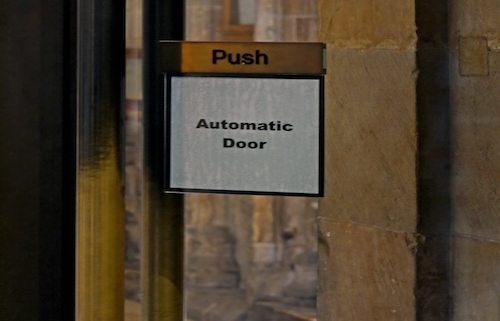Complementary Contradictions (part 14): Pairs in Review
Sometimes, you get conflicting words of advice, one which is good and the other which is not, and it requires discernment to determine which is the right advice to follow. But often, these seeming contradictions are, in reality, complementary and, when used appropriately and in the right way, can work together to help you make better decisions. In this series of articles and podcast episodes, we are looking at different leadership ideas or principles that seem to contradict, are opposite sides of a coin, or at least differ from each other and pairing them up to see how they actually complement each other to make you a better leader. Over the last 14 weeks, we have looked at 6 different pairs of ideas, and today we are going go back and do a quick review of them all.
Pair #1 – You see what you’re looking for, and you don’t see what you’re not looking for
The point we made with this pair was that, whether we realize it or not, we all develop perceptions of how we need to experience the world around us. Those perceptions tend to be based on either past experience, future expectation, or a combination of both. We either have an experience – positive or negative, real or imagined – or we have a specific expectation that we are anticipating, and we then form a perception based on which we look for a certain outcome, and only see the things that confirm that outcome. Consciously or not, we decide what we are looking for, and only see what affirms or confirms what we expect to see.
At the same time, and although we believe we notice everything (especially if we are looking) we tend to miss a lot of what is right in front of us, primarily because we are not looking for that specific thing in that specific way. When I am looking to see or find something, without realizing it, I am expecting it to look a certain way or be in a certain place, so I then overlook it when it is not in that place, or it looks different than what I remember or expect. Because our tendency is to only see what we are looking for, it takes a conscious effort to see things that we are not looking for.
Pair #2 – Zoom out and see the forest, and zoom in and see the trees
You have heard the saying, “You can’t see the forest for the trees,” and that was our primary metaphor for these contradictory, complementary ideas; contradictory in that you cannot do both things at the same time – see the forest AND see the trees – and complimentary in that you have to go back and forth – look at the forest, then at the trees, and back to the forest – repeatedly in order to successfully navigate where you are going and what you are doing.
The point we made with this pair was first about taking the time to see and understand the big picture. In successful leadership, you need to be able to get above the clouds and see the whole picture before you can drop back down to ground level and begin the process of directing, guiding, leading, and moving. If you don’t zoom out first, you won’t know where you are, you won’t know where you’re going, and you will end up someplace else. You can’t see the forest and the trees at the same time, so start by first zooming out to see the whole picture. But then, you need to zoom in to connect the dots, and identify and manage the details. And then make it a cyclical pattern in your leadership.
Pair #3 – When a plan comes together, and when a plan falls apart
With this pair, we applied the analogy of using a map for a road trip to show the importance of having an intentional and methodical process for assessing where you are, determining where you need to be, and drawing the map that shows how you will get there. The map is your plan, and therefore it is crucial for getting from here to there without getting lost. If you do it well, you will experience the joy of arriving at the destination that you have been eagerly anticipating. However, sometimes (to continue the road trip map analogy), the car breaks down, there is road construction and detours, or the rest stop is closed. Everything you planned out starts to fall apart, and you have to figure out what to do. You may have had the best of intentions, but it just doesn’t work out the way you wanted it to.
When that happens, what is most often going to be the best answer is to decide to accept reality and learn from it. At that point, the best thing you can do . . . is to do things differently, or start again, or make adjustments and corrections, or even throw it all out and move on to something else. Regardless of what happened, your plans fell apart. Sometimes the best of intentions come to naught, and all you can do is accept the circumstances and move forward.
Pair #4 – Do what works, or do something different
We began this pair by talking about the importance of figuring out what works, starting to do it, and continuing to do it. It’s been said that there is no need to reinvent the wheel, and what that means for you as a leader is that you don’t need to create a new plan and a new way of doing something every time you have to repeat the task or program. You don’t need to change something just for the sake of change, or because you think you know better even though you don’t have any data to support your idea. You may want to tweak the current strategy or tool to improve it, but you don’t need to start from scratch. You find what works and do it repeatedly . . . until you find that it doesn’t work.
If what you are doing didn’t work, is no longer working, or has never worked, it’s ok to scrap it and do something different. Don’t exercise insanity. Rather, step back onto the balcony to reassess the big picture, then zoom back in to make changes (the second pair of principles we talked about above). Then, make changes or start over. The bottom line is that you need to do what works, so if something is working, don’t change it (but make sure you evaluate it periodically to ensure that it is continuing to work the way that it should). However if, or when, it is not working, the best answer may simply be . . . do something different.
Pair #5 – Become a teacher, but first be teachable
This pair of principles focused on teaching, beginning with the understanding that you are a teacher. What I said was that you are already a teacher, even if you didn’t realize it, because you are modeling with your life, your actions, and your words, and others are learning from what they see you do and hear you say. I encouraged you, therefore, to be consciously intentional about those things. Own the fact that you are a teacher to your followers and do it with purpose.
However, in order to truly be an effective teacher, you yourself must first be teachable, because that attribute is one of the defining characteristics of a great teacher. You are already a teacher. If you want to be a great one, then you need to want to be teachable just as much as you want to be a teacher. So, humble yourself, open yourself up to receiving feedback, and be willing to honestly self-evaluate. Then, take that feedback and self-reflection, and grow.
Pair #6 – Close your mouth and use your ears, then open your mouth and use your words
With this pair of principles, we focused on the understanding that communication is a two-way street, involving both the sending and receiving of information (otherwise known as talking and listening). In my observation – and likely in yours – most people tend to do far more talking than listening. That’s why one half of this discussion is that one of the skills necessary for effective leadership (and for healthy relationships) is the ability to listen well. We need to be quicker to hear than to speak (James 1:19), and we need to be careful to hear the whole story (Proverbs 18:13). In other words, close your mouth, use your ears, and listen.
However, while this is definitely true, it does not mean that we can neglect the other side of that street – we also need to be good talkers. Good communication involves both talking and listening, and so even though we tend to do one (talking) to the neglect of the other (listening), we can’t ignore either one. Yes, listening is crucial to effective leadership, but so is the other side of the communication pathway – talking. We need to do them both well. Put effort into what you say, how you say it, and why you say it. Choose your words with purpose, and express them strategically and carefully.
At the outset, the goal in front of us was to see how these seeming contradictions are, in reality, complementary and can play well together so that you can use them to become a better leader. There are many situations you will face, many dilemmas to resolve, many choices to make, and many circumstances to address. Over the last 14 weeks, we’ve looked carefully at these six pairs so that we can learn lessons about how to lead well. The next step is up to you. Learn how to handle the challenges of leadership even better by putting these ideas together in your decision-making process. Applying these complimentary contradictions in practice will make you a better leader.





